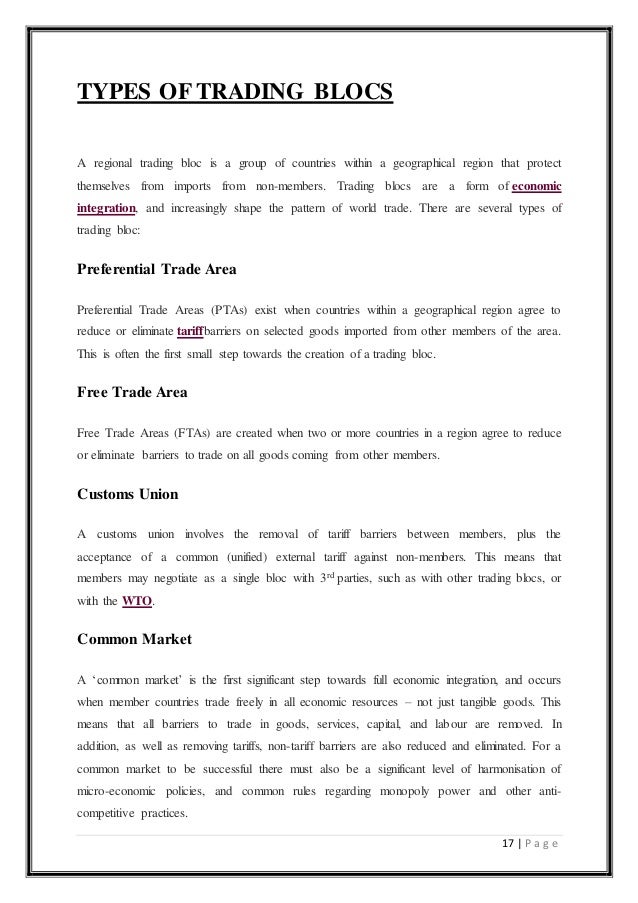
At its current pace, the RCEP is set to come into effect in early 2022 as all member nations have agreed to complete the ratification process within the year. So far, it’s been ratified by China, Japan, Thailand, and Singapore as of April 30, 2021. Once the RCEP is ratified by three-fifths of its signatories-a minimum of six ASEAN nations and three non-ASEAN nations-it will go ahead within 60 days. That means these nations still have to give their consent to be legally bound to the terms within the RCEP. Signing the agreement, the step taken in late 2020, is simply an initial show of support for the trade agreement, but now it needs to be ratified.
Types of trade blocs full#
Here are the countries which have signed on to be member nations:īut there is still some work to do to bring the trade agreement into full effect. Member nations who are a part of the RCEP will benefit from lowered or completely eliminated tariffs on imported goods and services within the region in the next 20 years.
Types of trade blocs free#
The RCEP is a free trade agreement between 15 nations in the Asia-Pacific region, and has been formalized after 28 rounds of discussion over eight years. Who’s in the RCEP, and Why Was it Created? Here, we break down everything you need to know about it, from who’s involved to its implications. In late 2020, the Regional Comprehensive Economic Partnership (RCEP) was signed, officially creating the biggest trade bloc in history. Naturally, agreements among nations in a certain geographical area help facilitate relationships in ways that are ideally beneficial for everyone involved. Trade and commerce are the lifeblood of the global economy. The United States and India continues to hold discussions on trade issues.RCEP Explained: The World’s Biggest Trading Bloc Termination of GSP benefits removed special duty treatment for $5.6 billion of Indian exports to the United States, affecting India’s export-oriented sectors such as pharmaceuticals, textiles, agricultural products, and automotive parts. In April 2018, the United States launched an eligibility review of India’s compliance with the General System of Preferences (GSP) market access criteria, and in March 2019 decided that India no longer met the criteria and revoked India’s GSP status. There is no trade agreement between India and the United States. India Korea Comprehensive Economic Partnership Agreements Japan India Comprehensive Economic Partnership Agreements India Singapore Comprehensive Economic Cooperation Agreement

Indo Malaysia Comprehensive Economic Cooperation Agreement India, Pakistan, Nepal, Sri Lanka, Bangladesh, Bhutan, and the Maldives Economic Development Organizations (EDO)īangladesh, China, India, Lao PDR, Republic of Korea, Sri Lanka.īrunei, Cambodia, Indonesia, Laos, Malaysia, Myanmar, Philippines, Singapore, Thailand, Vietnam, and India.Īlgeria, Argentina, Bangladesh, Benin, Bolivia, Brazil, Cameroon, Chile, Colombia, Cuba, Republic of Korea, Ecuador, Egypt, Ghana, Guinea, Guyana, India, Indonesia, Iran, Iraq, Libya, Malaysia, Mexico, Morocco, Mozambique, Myanmar, Nicaragua, Nigeria, Pakistan, Peru, Philippines, Republic of Korea, Singapore, Sri Lanka, Sudan, Thailand, Trinidad and Tobago, Tunisia, Tanzania, Venezuela, Vietnam, Zimbabwe.


Facing a Foreign Trade AD/CVD or Safeguard Investigation?.


 0 kommentar(er)
0 kommentar(er)
